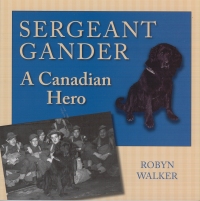| ________________
CM . . .
. Volume XVI Number 28. . . .March 26, 2010
excerpt:
Sergeant Gander is the story of a Newfoundland dog and his history as a war hero. Originally called Pal, his name was changed to Gander when he was given by the Hayden family, whose pet he was, to the Royal Rifles of Canada. Stationed at Gander, the unit was delighted to receive the dog and promptly renamed him Gander. Included is background information on the Newfoundland breed of dog and its many fine qualities. When the Royal Rifles were sent to Hong Kong to protect it from Japanese attack during the Second World War, Gander, their mascot, went too. The Japanese attacked the British colony on December 8, 1941. During the Battle for Hong Kong, Gander saved seven wounded soldiers from certain death. When a grenade landed near them, the big dog grabbed it in his mouth and ran towards the Japanese soldiers. He didn’t survive. For his heroism, after the war, Gander received the PDSA Dickin Medal. This was established by Maria Dickin, a wealthy English woman, who founded the People’s Dispensary for Sick Animals in 1917 to care for neglected animals in London’s east end. The Hong Kong Veterans’ Association applied for this award in Gander’s memory, and the PDSA agreed to its request. Sergeant Gander is well researched and historically accurate. It is also unusual because it is the biography of a dog, but an unusual dog with many human qualities. It is an attractive book, very well illustrated with many functional black and white photographs spread throughout. It also has nine useful maps, an index, a very good bibliography and excellent notes. The latter are used to explain the significance of things mentioned in the text. Placed at the end of the book, they would have been more useful if inserted in the text where they are mentioned. In addition, there are many inserts with information about people and subjects mentioned or relevant to the story. These add much needed depth to the book. One, for example, is about Sergeant Major John Osborne who saved his fellow soldiers from instant death by throwing himself on top of a hand grenade. Like Gander, he didn’t survive. For this heroic act, he received the Victoria Cross posthumously, the only soldier in the battle to be so honoured. Unfortunately, while Gander was a wonderful dog, there is insufficient information on him for a book. He is barely mentioned. A book on the Royal Rifles could have included a chapter on him. The addition of the many photographs and inserts save the book and help make it a valuable learning tool. However, the inclusion of three appendices is of dubious value. Out of 161 pages of text, they take up 63. The first, Appendix A, lists all of the animals that received the PDSA Dickin Medal. Pigeons top the list. This information could have been omitted without weakening the book. The inclusion of the other two appendices is understandable, even if their content is of little value. Appendix B is a list of “C” Force Royal Rifles who went to Hong Kong. These were soldiers who were “not recommended for operational employment at present” because they needed further training. Appendix C is list of the soldiers who were killed or missing in action during the Battle for Hong Kong. Robyn Walker, the author of Sergeant Gander is a school librarian and freelance writer. She has degrees in history, library science and education. This is her first book. Recommended. Thomas F. Chambers, a retired college teacher, lives in North Bay, ON.
To comment
on this title or this review, send mail to cm@umanitoba.ca.
Copyright © the Manitoba Library Association. Reproduction for personal
use is permitted only if this copyright notice is maintained. Any
other reproduction is prohibited without permission.
NEXT REVIEW |
TABLE OF CONTENTS FOR THIS ISSUE
- March 26, 2010.
AUTHORS |
TITLES |
MEDIA REVIEWS |
PROFILES |
BACK ISSUES |
SEARCH |
CMARCHIVE |
HOME |
